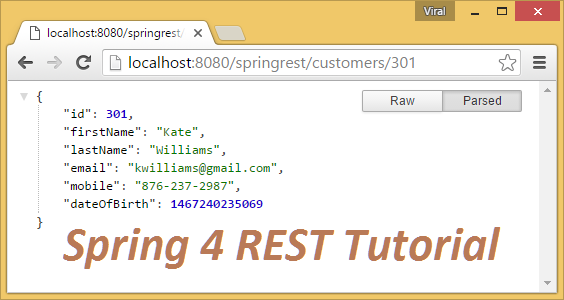
Spring 4 MVC REST Controller Service Example (JSON CRUD Tutorial) – A step by step tutorial to understand Spring 4 MVC REST API and to create RESTful service using Spring 4.
Spring 4 MVC REST provides powerful APIs to built complete RESTful services. Let us understand the core concept and create simple web application using Maven and make our CRUD based REST service.
Getting started with Spring 4 MVC REST Controller
For this project we will use following tools and technologies.
- Java 1.7
- Spring MVC 4.3.0.RELEASE
- Tomcat 7
- Maven 3
- POSTMan (optional)
The demo REST application will have Customer resource. This customer resource can be accessed using standard GET, POST, PUT, DELETE http methods. We will create below REST endpoints for this project.
| REST Endpoint | HTTP Method | Description |
|---|---|---|
/customers | GET | Returns the list of customers |
/customers/{id} | GET | Returns customer detail for given customer {id} |
/customers | POST | Creates new customer from the post data |
/customers/{id} | PUT | Replace the details for given customer {id} |
/customers/{id} | DELETE | Delete the customer for given customer {id} |
1. Create a new Maven Project
If you are using Eclipse then you can use M2Eclipse plugin. Check the tutorial Spring 4 MVC Hello World and follow the section 1.
Alternatively if you want to generate Maven webapp using mvn command then follow these steps.
Code language: Bash (bash)mvn archetype:create -DgroupId=net.viralpatel.spring -DartifactId=SpringRest -DarchetypeArtifactId=maven-archetype-webapp
This will generate maven application with default project directory structure. You can then run following command and convert the project in Eclipse project.
Code language: Bash (bash)mvn eclipse:eclipse
And then simply import the project in Eclipse.
2. Add Spring 4 MVC Maven dependencies (Update pom.xml)
Project structure is created. Now let’s start and add first the maven dependencies for Spring 4 MVC REST in our pom.xml file.
Update pom.xml file and add following dependencies.
pom.xml
<?xml version="1.0" encoding="UTF-8"?>
<project xmlns="http://maven.apache.org/POM/4.0.0" xmlns:xsi="http://www.w3.org/2001/XMLSchema-instance" xsi:schemalocation="http://maven.apache.org/POM/4.0.0 http://maven.apache.org/maven-v4_0_0.xsd">
<modelversion>4.0.0</modelversion>
<groupid>net.viralpatel.spring</groupid>
<artifactid>Spring4Rest</artifactid>
<packaging>war</packaging>
<version>0.0.1-SNAPSHOT</version>
<name>Spring 4 Rest Service CRUD Example</name>
<url>http://maven.apache.org</url>
<properties>
<java-version>1.7</java-version>
<springframework.version>4.3.1.RELEASE</springframework.version>
<jackson.version>2.7.5</jackson.version>
</properties>
<dependencies>
<dependency>
<groupid>org.springframework</groupid>
<artifactid>spring-webmvc</artifactid>
<version>${springframework.version}</version>
</dependency>
<dependency>
<groupid>com.fasterxml.jackson.core</groupid>
<artifactid>jackson-databind</artifactid>
<version>${jackson.version}</version>
</dependency>
<dependency>
<groupid>javax.servlet</groupid>
<artifactid>javax.servlet-api</artifactid>
<version>3.0.1</version>
<scope>provided</scope>
</dependency>
</dependencies>
<build>
<finalname>HelloWorld</finalname>
<pluginmanagement>
<plugins>
<plugin>
<groupid>org.apache.tomcat.maven</groupid>
<artifactid>tomcat7-maven-plugin</artifactid>
<version>2.2</version>
<configuration>
<path>/springrest</path>
</configuration>
</plugin>
</plugins>
</pluginmanagement>
</build>
</project>Code language: HTML, XML (xml)After updating pom.xml, Eclipse’s maven plugin should start resolving the dependencies.
3. Set Annotation based Configuration for Spring 4 MVC REST
For this Spring 4 MVC REST tutorial we are going to use Spring’s Java based configuration or annotation based configuration instead of old XML configuration. So now let us add the Java Configuration required to bootstrap Spring 4 MVC REST in our webapp.
Create AppConfig.java file under /src folder. Give appropriate package name to your file. We are using @EnableWebMvc, @ComponentScan and @Configuration annotations. These will bootstrap the spring mvc application and set package to scan controllers and resources.
/src/main/java/net/viralpatel/spring/config/AppConfig.java
package net.viralpatel.spring.config;
import org.springframework.context.annotation.ComponentScan;
import org.springframework.context.annotation.Configuration;
import org.springframework.web.servlet.config.annotation.EnableWebMvc;
@Configuration
@EnableWebMvc
@ComponentScan(basePackages = "net.viralpatel.spring")
public class AppConfig {
}Code language: Java (java)4. Set Servlet 3 Java Configuration
Create AppInitializer class under config package. This class will replace web.xml and it will map the spring’s dispatcher servlet and bootstrap it.
/src/main/java/net/viralpatel/spring/config/AppInitializer.java
package net.viralpatel.spring.config;
import org.springframework.web.servlet.support.AbstractAnnotationConfigDispatcherServletInitializer;
public class AppInitializer extends AbstractAnnotationConfigDispatcherServletInitializer {
@Override
protected Class[] getRootConfigClasses() {
return new Class[] { AppConfig.class };
}
@Override
protected Class[] getServletConfigClasses() {
return null;
}
@Override
protected String[] getServletMappings() {
return new String[] { "/" };
}
}Code language: Java (java)We have configured the dispatcher servlet using standard Java based configuration instead of the older web.xml. Thus web.xml is no longer required and we can simply delete it.
5. Create the Customer Model
Next let us create Customer model class that will have few properties such as firstName, lastName, email etc. This bean will hold customer information.
/src/main/java/net/viralpatel/spring/model/Customer.java
package net.viralpatel.spring.model;
import java.util.Date;
public class Customer {
private Long id;
private String firstName;
private String lastName;
private String email;
private String mobile;
private Date dateOfBirth;
public Customer(long id, String firstName, String lastName, String email, String mobile) {
this.id = id;
this.firstName = firstName;
this.lastName = lastName;
this.email = email;
this.mobile = mobile;
this.dateOfBirth = new Date();
}
public Customer() {
}
//... Getter and setter methods
}Code language: Java (java)6. Create the Dummy Customer Data Access Object (DAO)
Instead of storing the customer data in database and to make this example simple, we will create a dummy data access object that will store customer details in a list. This DAO class can be easily replaced with Spring Data DAO or custom DAO. But for this example we will keep it easy.
The CustomerDAO contains methods list(), get(), create(), update() and delete() to perform CRUD operation on customers.
/src/main/java/net/viralpatel/spring/dao/CustomerDAO.java
package net.viralpatel.spring.dao;
import java.util.ArrayList;
import java.util.List;
import org.springframework.stereotype.Component;
import net.viralpatel.spring.model.Customer;
@Component
public class CustomerDAO {
// Dummy database. Initialize with some dummy values.
private static List<Customer> customers;
{
customers = new ArrayList();
customers.add(new Customer(101, "John", "Doe", "[email protected]", "121-232-3435"));
customers.add(new Customer(201, "Russ", "Smith", "[email protected]", "343-545-2345"));
customers.add(new Customer(301, "Kate", "Williams", "[email protected]", "876-237-2987"));
customers.add(new Customer(System.currentTimeMillis(), "Viral", "Patel", "[email protected]", "356-758-8736"));
}
/**
* Returns list of customers from dummy database.
*
* @return list of customers
*/
public List list() {
return customers;
}
/**
* Return customer object for given id from dummy database. If customer is
* not found for id, returns null.
*
* @param id
* customer id
* @return customer object for given id
*/
public Customer get(Long id) {
for (Customer c : customers) {
if (c.getId().equals(id)) {
return c;
}
}
return null;
}
/**
* Create new customer in dummy database. Updates the id and insert new
* customer in list.
*
* @param customer
* Customer object
* @return customer object with updated id
*/
public Customer create(Customer customer) {
customer.setId(System.currentTimeMillis());
customers.add(customer);
return customer;
}
/**
* Delete the customer object from dummy database. If customer not found for
* given id, returns null.
*
* @param id
* the customer id
* @return id of deleted customer object
*/
public Long delete(Long id) {
for (Customer c : customers) {
if (c.getId().equals(id)) {
customers.remove(c);
return id;
}
}
return null;
}
/**
* Update the customer object for given id in dummy database. If customer
* not exists, returns null
*
* @param id
* @param customer
* @return customer object with id
*/
public Customer update(Long id, Customer customer) {
for (Customer c : customers) {
if (c.getId().equals(id)) {
customer.setId(c.getId());
customers.remove(c);
customers.add(customer);
return customer;
}
}
return null;
}
}Code language: Java (java)7. Create the Customer REST Controller
Now let us create CustomerRestController class. This class is annotated with @RestController annotation. Also note that we are using new annotations @GetMapping, @PostMapping, @PutMapping and @DeleteMapping instead of standard @RequestMapping. These annotations are available since Spring MVC 4.3 and are standard way of defining REST endpoints. They act as wrapper to @RequestMapping. For example @GetMapping is a composed annotation that acts as a shortcut for @RequestMapping(method = RequestMethod.GET).
/src/main/java/net/viralpatel/spring/controller/CustomerRestController.java
package net.viralpatel.spring.controller;
import java.util.List;
import org.springframework.beans.factory.annotation.Autowired;
import org.springframework.http.HttpStatus;
import org.springframework.http.ResponseEntity;
import org.springframework.web.bind.annotation.DeleteMapping;
import org.springframework.web.bind.annotation.GetMapping;
import org.springframework.web.bind.annotation.PathVariable;
import org.springframework.web.bind.annotation.PostMapping;
import org.springframework.web.bind.annotation.PutMapping;
import org.springframework.web.bind.annotation.RequestBody;
import org.springframework.web.bind.annotation.RestController;
import net.viralpatel.spring.dao.CustomerDAO;
import net.viralpatel.spring.model.Customer;
@RestController
public class CustomerRestController {
@Autowired
private CustomerDAO customerDAO;
@GetMapping("/customers")
public List getCustomers() {
return customerDAO.list();
}
@GetMapping("/customers/{id}")
public ResponseEntity getCustomer(@PathVariable("id") Long id) {
Customer customer = customerDAO.get(id);
if (customer == null) {
return new ResponseEntity("No Customer found for ID " + id, HttpStatus.NOT_FOUND);
}
return new ResponseEntity(customer, HttpStatus.OK);
}
@PostMapping(value = "/customers")
public ResponseEntity createCustomer(@RequestBody Customer customer) {
customerDAO.create(customer);
return new ResponseEntity(customer, HttpStatus.OK);
}
@DeleteMapping("/customers/{id}")
public ResponseEntity deleteCustomer(@PathVariable Long id) {
if (null == customerDAO.delete(id)) {
return new ResponseEntity("No Customer found for ID " + id, HttpStatus.NOT_FOUND);
}
return new ResponseEntity(id, HttpStatus.OK);
}
@PutMapping("/customers/{id}")
public ResponseEntity updateCustomer(@PathVariable Long id, @RequestBody Customer customer) {
customer = customerDAO.update(id, customer);
if (null == customer) {
return new ResponseEntity("No Customer found for ID " + id, HttpStatus.NOT_FOUND);
}
return new ResponseEntity(customer, HttpStatus.OK);
}
}Code language: Java (java)That’s All Folks
Let us execute the Spring REST project. In Eclipse you can start Tomcat and run the project inside it. Or you can run the project using Embedded Tomcat using Maven.
Once the application starts successfully, launch the browser and open http://localhost:8080/springrest/customers. This hit the /customers end point and will list down all the customers.
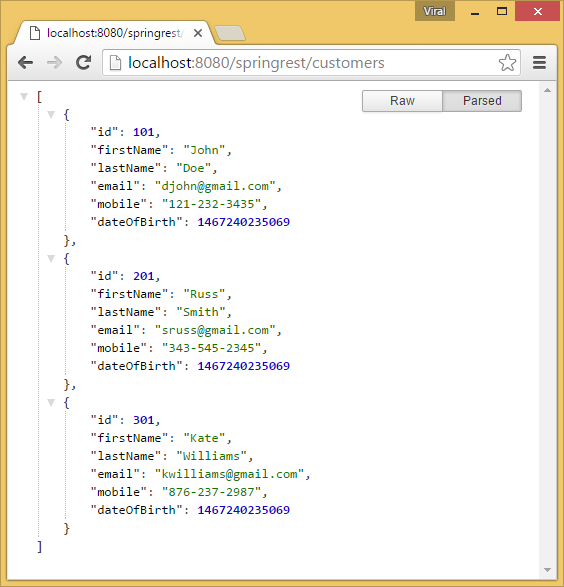
Next we can try GET method by hitting http://localhost:8080/springrest/customers/{id} endpoint. This will display details of customer for given id.
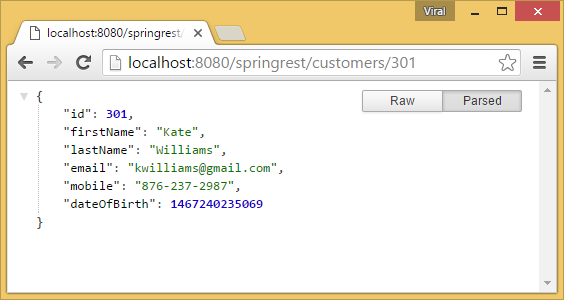
Also you can POST the customer details to http://localhost:8080/springrest/customers using POSTMan extension. Once you do that, the new customer will be created and same can be viewed under /customers endpoint.
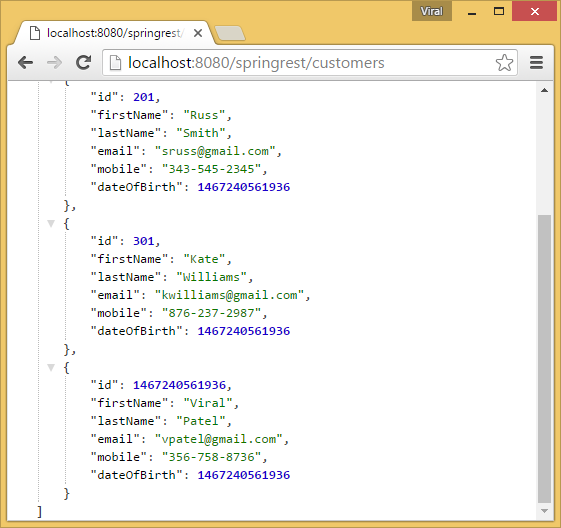
Download Source Code – Spring 4 REST Tutorial
Source code of this Spring 4 REST Controller tutorial is available in Github.
- Download – spring4-rest-example.zip (6.54 KB)
- Github – spring4-rest-example.git

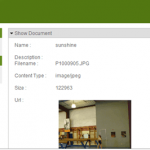
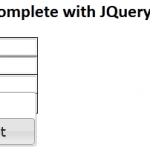
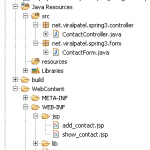
1. You can use a map since you are using ID for customer model, this is to make it efficient.
2. It would be interesting to see Jpa Repository integrated in this demo app. That would take dummy code out of picture altogether.
3. Tweet again when it works in the first attempt :)
Thanks Vimal.. Integration with Spring Data is coming next.
maybe this is a bit late but i have modified the code to include a HashMap
private static HashMap customers;
{
customers = new HashMap();
customers.put(101, new Customer(101, “John”, “Doe”, “[email protected]”, “121-232-3435”));
customers.put(201, new Customer(201, “Russ”, “Smith”, “[email protected]”, “343-545-2345”));
customers.put(301, new Customer(301, “Kate”, “Williams”, “[email protected]”, “876-237-2987”));
}
I am facing this issue :(
Mar 07, 2017 12:02:17 PM org.apache.catalina.core.StandardContext listenerStart
SEVERE: Exception sending context initialized event to listener instance of clas
s org.springframework.web.context.ContextLoaderListener
java.lang.IllegalStateException: Cannot initialize context because there is alre
ady a root application context present – check whether you have multiple Context
Loader* definitions in your web.xml!
The blog looks good when you read it. However,wWhen you click on Download link (spring-rest-example.zip) you get “spring4-mvc-example-master (1).zip” and when you go to github and download the zip file you get “spring4-restful-example-master.zip”. Regardless both of them does not work.
I have changed the jva version to 1.8 and tried without anysuccess.
Hi Krishnan, Thanks for your feedback. I have fixed the Download link. Now you should be able to download correct source. Did you try running mvn tomcat7:run and execute the project? Let me know what errors are you getting while running this example.
same for me its not working at all…….
Hi Virat,
Thanks for such a nice blog
I have followed all the steps, and when i tried accessing below url
http://localhost:8080/SpringRest/
i can see o/p as “Hello World”
but when i am trying below url:
http://localhost:8080/SpringRest/customers
o/p is “404-page not found”
re verified all the steps but same o/p.
could you kindly help
That means either CustomerRestController or AppConfig may have issues.
1) check your annotations in CustomerRestController.java file
2) check the @ComponentScan(Buildpaths=”YOUR_PACKAGE_NAME “) in AppConfig.java file
Hi, I had the same issue and fixed it by extend the @ComponentScan form @ComponentScan(basePackages = “net.viralpatel.spring”) to @ComponentScan(basePackages = “net.viralpatel.spring.*”) in the AppConfig class.
By the way, I liked this pretty compact tutorial, even it lacked the setter and getter in CustomerDAO class and the former mentioned issue. Greetings, Olli
Build failing
Error assembling WAR: webxml attribute is required (or pre-existing WEB-INF/web.xml if executing in update mode) –
did you get this resolved. please let me know
You can add this in the plugin section of pom.xml to avoid this error:
maven-war-plugin
2.4
false
follow this to add Dynamic web module for java . 7 or latter.
Hi
Thanks for your guide.
I tried it on Tomcat 7 with JRE 7 and it works fine.
I modified the pom.xml adding the maven-war-plugin 2.6 with the failOnMissingWebXml=false to deploy the war on JBoss with JRE 7.
On JBoss 7 or JBoss EAP 6 the module is deployed and the welcome page works but the /customers or /customers/{id} call doesn’t work.
>JBWEB000069: description JBWEB000124: The requested resource is not available.
Any idea ?
Thanks
Carmen
did you figure it out?
I have same issue; works in Tomcat 8.
Hi Viral, nice REST server.
Any chance of seeing this code integrated with an AngularJS front-end/UI?
Will
Excellent thanks…. helped me to understand many points which were creating error in my project :-)
Hi Viral, nice REST server.
Any chance of seeing this code integrated with an AngularJS front-end/UI?
Will
its vary simple, make a ajax call and store the data into a variable. then all your data will be at front end then you can play with ng-repeat and ng-bind. That’s all..!
i have the same question as will
Build failing
Error assembling WAR: webxml attribute is required (or pre-existing WEB-INF/web.xml if executing in update mode) –
figured it out.
org.apache.maven.plugins
maven-war-plugin
false
Hi,
Is there a way we can have both Spring MVC and Struts2 in a single web app project?
If so do you have any samples of such project.
Thanks for sharing it was very useful to under the concept.
i am getting this error when i configure project java based ,Please help
Oct 17, 2016 5:19:31 PM org.apache.catalina.core.AprLifecycleListener init
INFO: The APR based Apache Tomcat Native library which allows optimal performance in production environments was not found on the java.library.path: C:\Program Files\Java\jre1.8.0_45\bin;C:\Windows\Sun\Java\bin;C:\Windows\system32;C:\Windows;C:/Program Files/Java/jre1.8.0_45/bin/server;C:/Program Files/Java/jre1.8.0_45/bin;C:/Program Files/Java/jre1.8.0_45/lib/amd64;C:\oracle\product\10.2.0\client_1\bin;C:\ProgramData\Oracle\Java\javapath;C:\Windows\system32;C:\Windows;C:\Windows\System32\Wbem;C:\Windows\System32\WindowsPowerShell\v1.0\;C:\Program Files (x86)\Fuse\;C:\Program Files (x86)\Skype\Phone\;C:\Program Files\nodejs\;C:\Users\ghulam.abbas\AppData\Roaming\npm;D:\eclipse;;.
Oct 17, 2016 5:19:31 PM org.apache.tomcat.util.digester.SetPropertiesRule begin
WARNING: [SetPropertiesRule]{Server/Service/Engine/Host/Context} Setting property ‘source’ to ‘org.eclipse.jst.jee.server:Spring4Rest’ did not find a matching property.
Oct 17, 2016 5:19:31 PM org.apache.coyote.AbstractProtocol init
INFO: Initializing ProtocolHandler [“http-bio-8080”]
Oct 17, 2016 5:19:31 PM org.apache.coyote.AbstractProtocol init
INFO: Initializing ProtocolHandler [“ajp-bio-8009”]
Oct 17, 2016 5:19:31 PM org.apache.catalina.startup.Catalina load
INFO: Initialization processed in 328 ms
Oct 17, 2016 5:19:31 PM org.apache.catalina.core.StandardService startInternal
INFO: Starting service Catalina
Oct 17, 2016 5:19:31 PM org.apache.catalina.core.StandardEngine startInternal
INFO: Starting Servlet Engine: Apache Tomcat/7.0.47
Oct 17, 2016 5:19:31 PM org.apache.coyote.AbstractProtocol start
INFO: Starting ProtocolHandler [“http-bio-8080”]
Oct 17, 2016 5:19:31 PM org.apache.coyote.AbstractProtocol start
INFO: Starting ProtocolHandler [“ajp-bio-8009”]
Oct 17, 2016 5:19:31 PM org.apache.catalina.startup.Catalina start
INFO: Server startup in 304 ms
How can I handle requestparam with bracket :
myhost.com?film&sort[title]=desc
myhost.com?==:film&sort[webname]=desc
Hi ,
Thank you so much for such excellent tutorial .
I am using Postman to send the requests to this web service. But how do I pass customer object in the body of the http post request for creating a customer .
Excellent job. Thank you so much :)
Awesome Post Sir Very Clean Explanation. Thanks For Posting
can u please tell how to pass list/data to jsp using getmapping method.
It should be mvn archetype:generate for creating the project. The tutorial, otherwise is a good starting point. Thanks
You’re right
How can I generate response in XML ? Response getting is in JSONArray format.Can anyone please help.
Very nice tutorial.But one question,this code is always returning response in JSON format.How can I change it to XML ? Can any one please suggest ?
public Customer get(Long id) {
for (Customer c :customers) {
if (c.getId().equals(id)) {
return c;
}
}
return null;
}
==> In the for loop of CustomerDAO class , I am getting error ; because here customers is of object type and “c” of type user defined Customer type .So here type mismatch error I am getting. Could you you please help me.
The arraylist should be containing a generic type of Customer object. so declare it as List customers instead of just List customers
solved this by using references to generic type List
see below:
private static List customers;
{
customers = new ArrayList();
customers.add(new Customer(101, “John”, “Doe”, “[email protected]”, “121-232-3435”));
customers.add(new Customer(201, “Russ”, “Smith”, “[email protected]”, “343-545-2345”));
customers.add(new Customer(301, “Kate”, “Williams”, “[email protected]”, “876-237-2987”));
}
Very nice blog . Its working for me.Patel Jee.
org.apache.tomcat.maven
tomcat7-maven-plugin
2.2
/springrest
maven-war-plugin
2.4
false
Very Good Post, Thanks for sharing.
Hi ,
Iam getting 404 error while accessing : http://localhost:8080/spring/customers
please let me know what to do ? I have followed the same as in documentation.
Hi ,
Iam getting page not found error while accessing : http://localhost:8080/spring/customers
please let me know what to do ? I have followed the same as in documentation.
Hi,
any one please give me the solution for this error? Please??
for the error http://localhost:8080/spring/customers not found.
firstly : add the old web.xml back.
secondly: in pom.xml , remove the only leave as below:
org.apache.tomcat.maven
tomcat7-maven-plugin
2.2
thirdly : access it like : http://localhost:8080/webService/customers eg: webService is my project name
secondly: in pom.xml , remove the one line “configutation” at the bottom part plugin area
for fixing the http://localhost:8080/spring/customers not found error, change the code in this manner :
1. rename AppInitializer to AppWebConfig
2. rename the AppConfig to AppInitializer
3. change the getServletConfigClasses() method this way:
@Override
protected Class[] getServletConfigClasses() {
return new Class[]{AppWebConfig.class};
}
4. create a class named AppRootConfig
5. add the @Component annotation to the CustomerDao class so that is can be found by the autowiring mechanism.
in the end, the classes should look like this :
public class AppInitializer extends AbstractAnnotationConfigDispatcherServletInitializer{
[…]
@Override
protected Class[] getServletConfigClasses() {
return new Class[]{AppWebConfig.class};
}
[…]
@Configuration
@ComponentScan(basePackages = YOUR_BASE_PACKAGE, excludeFilters = {@Filter(type = FilterType.ANNOTATION, value = EnableWebMvc.class)})
public class AppRootConfig {
}
@Configuration
@EnableWebMvc
@ComponentScan(basePackages = “it.rest.zapp”)
public class AppWebConfig {
}
@Component
public class CustomerDao {
[…]
}
for executing the app with the embedded tomcat plugin, follow these steps:
1. delete the web.xml file
2. change the pom.xml file by adding the following plugins :
org.apache.maven.plugins
maven-compiler-plugin
2.3.2
${versions.java}
${versions.java}
org.apache.maven.plugins
maven-war-plugin
2.4
src/main/webapp
${project.name}
false
by default the tomcat plugin uses the 8080 port. if you want to use a different one, change tomcat7-maven-plugin like so:
org.apache.tomcat.maven
tomcat7-maven-plugin
2.2
4040
forgot to say that the getRootConfigClasses() method changes also.
the complete AppInitializer class is like this:
public class AppInitializer extends AbstractAnnotationConfigDispatcherServletInitializer{
@Override
protected Class[] getRootConfigClasses() {
return new Class[]{AppRootConfig.class};
}
@Override
protected Class[] getServletConfigClasses() {
return new Class[]{AppWebConfig.class};
}
@Override
protected String[] getServletMappings() {
return new String[]{“/”};
}
}
If you are trying to do a “Maven Build” from eclipse, you must add the goal “spring-boot:run”, otherwise it won’t initialize the spring boot and you won’t be able to see the pages.
HI
Good article, but I am facing issues when I try to http://localhost:8080/spring/customers
WARNING: No mapping found for HTTP request with URI [/SpringRest/] in DispatcherServlet with name ‘dispatcher’
I am using inteliJ IDE
thanks,
Bala
same problem here
Are you using “mvn tomcat7:run”? If you create a run configuration and add “Spring4Rest:war exploded” artifact to deploy, then it won’t work. Because there is no web.xml and path definition is in pom.xml.
Useful website…. keep up the good work
Hi all, I try to run by Eclipse but It’s fail.
First, I clone code from his github -> mvn eclipse:eclipse -> Import to Eclipse -> Add Tomcat Server -> Run Tomcat Server. But It’s 404.
Do I wrong or missing other steeps….
Can anyone help me !! Thank you very much
very useful website..great work!!
Thank you for ‘Spring 4 MVC REST Controller Example’. Good work!
This is pretty obviously broken code and you should take it down. It provides a bad example for others to work on that are just getting into java. Specifically,
public Customer get(Long id) {
for (Customer c : customers) {
if (c.getId().equals(id)) {
return c;
}
}
return null;
}
clearly doesn’t compile as you are trying to compare an object and a class. Please either fix this blog post or take it down.
got error at same point .
have you found any solution to this??
I am using STS ..but when i hit URL http://localhost:8080/spring/customers 404 error is coming..
what is the use of delete method here , I can even perform delete by using GET/POST method
Kindly explain.
I need a help, how to use xml instead if json for the same project
Usefull post for beginner.
Thanks.
Very nice article Viral,
Your article provides complete step by step guidance on creating RESTful web service using Spring4. I agree with your point that Spring 4 MVC REST provides more powerful APIs to built complete RESTful web service. Nowadays, RESTful web services are in trend instead of the SOAP web services. RESTful web services permit other data formats like HTML, XML, plain text for communication between different applications.
How can I search customers by passing Customer JSON object , can we change the endpoint to /customer/searchCustomer ??
Awesome. This is exactly what i am looking for. Thank you Viral !
hello, could anyone help me, is giving error in this class: Type mismatch: cannot convert from element type Object to Customer.
@Component
public class CustomerDAO {
private static List clientes;
{
clientes = new ArrayList();
clientes.add(new Customer(101, “João”, “Benedito”, “[email protected]”, “123-456-7890”));
clientes.add(new Customer(201, “José”, “Maria”, “[email protected]”, “321-654-0987”));
clientes.add(new Customer(301, “Maria”, “José”, “[email protected]”, “987-654-3210”));
}
public List list() {
return clientes;
}
public Customer get(Long id) {
for (Customer c : clientes) {
if (c.getId().equals(id)) {
return c;
}
}
return null;
}
public Customer create(Customer cliente) {
cliente.setId(System.currentTimeMillis());
clientes.add(cliente);
return cliente;
}
public Long delete(Long id) {
for (Customer c : clientes) {
if (c.getId().equals(id)) {
clientes.remove(c);
return id;
}
}
return null;
}
public Customer update(Long id, Customer cliente) {
for (Customer c : clientes) {
if (c.getId().equals(id)) {
cliente.setId(c.getId());
clientes.remove(c);
clientes.add(cliente);
return cliente;
}
}
return null;
}
}
Hello everyone, I have been able to solve this problem.
private static List clientes;
{
clientes = new ArrayList();
clientes.add(new Customer(101, “João”, “Benedito”, “[email protected]”, “123-456-7890”));
clientes.add(new Customer(201, “José”, “Maria”, “[email protected]”, “321-654-0987”));
clientes.add(new Customer(301, “Maria”, “José”, “[email protected]”, “987-654-3210”));
}
public List list() {
return clientes;
}
that worked
Thanks
Hi,
First of all thanks for a quick setup.
To make it run on tomcat I had to put this “@JsonIgnoreProperties({“hibernateLazyInitializer”, “handler”})” on Customer class.
After that I have an issue with the json response. When I put the debugger on method it returns the Array list but in the http response it is throwing empty list like this [{},{}].
Can somebody please help me am I missing anything ?
How to upload sample code
hi i am getting error like
—cannot convert from element type Object to String
in customerDao at for loop
here— for (Customer c : customers) {
I had some issues to, but after reading all the comments here i actually run successfully the example. Awesome. Thanks!